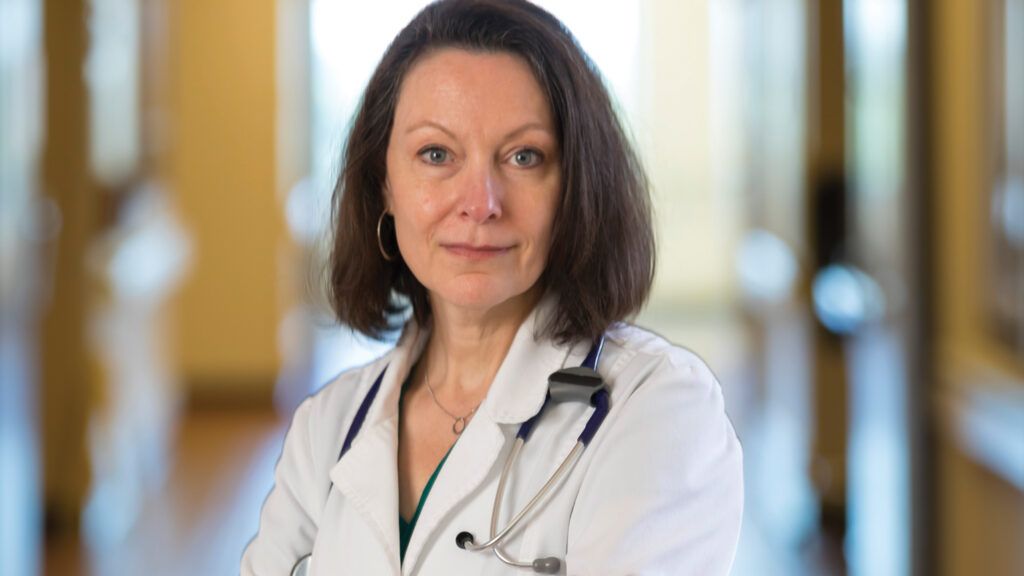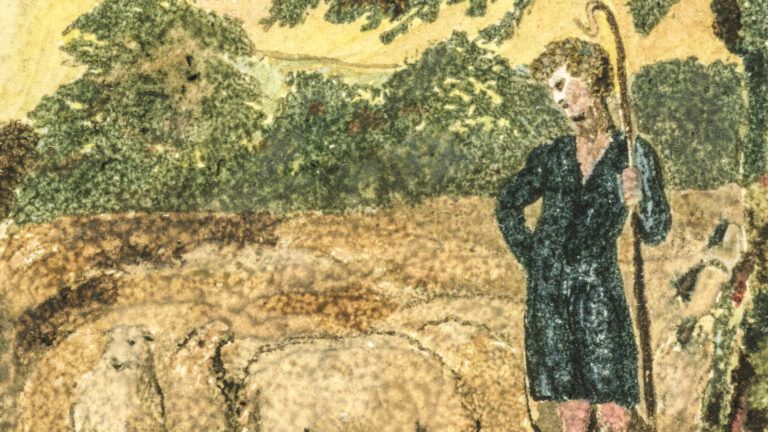Laurin Bellg has practiced medicine for more than 20 years, specializing in critical care. While working in intensive care units, she has encountered several patients who’ve had near-death experiences (NDEs). Her book, Near Death in the ICU, focuses on the importance of doctors listening to their patients’ mysterious experiences. Her interest in the value of these stories started with two inexplicable experiences: that of one of her first patients—and her own.
The little girl looked familiar. She sat in the corner of my hospital room, staring out the window. She wasn’t looking at me or saying anything. She seemed serene. I found her presence uplifting after a harrowing week of being severely ill. But who was she? And what was she doing here in my hospital room?
I’d been admitted to the hospital a few days before, diagnosed with septic shock from a urinary tract infection. I was in my mid-twenties and too focused on my job in viral research to pay attention to my symptoms. It didn’t occur to me that I had an infection that moved to my kidneys until I became sick. Really sick. My husband, J.C., came home from work to find me barely conscious, with a fever of 105°. I don’t even remember going to the hospital.
The doctors immediately started me on antibiotics and monitored my condition closely. Those first few days, I was improving but still pretty out of it, drifting in and out. One afternoon, I was awake and lying on my side, facing the window. I was hooked up to an IV, the medicine slowly infusing into my veins, the heart monitor making steady beeps. J.C. sat nearby. That’s when I noticed the little girl.
She was about 10 years old. Her short red hair was parted on the side and pulled back with a plastic barrette. She wore a simple cotton dress, cardigan and white ankle socks with Mary Jane shoes. It was similar to outfits I’d worn as a child, growing up in the 1960s.
“Who is that?” I asked my husband.
“Who?” he asked, looking up from his magazine.
“The girl in the corner.”
J.C. glanced over, then looked concerned. “There’s no one there.”
Was I hallucinating? I could see her; he couldn’t. It didn’t make sense. I’m a fairly logical person. It’s what prompted me to go into research, what made me want to be a doctor. I’d just been accepted into medical school at the University of Tennessee. I’d been waiting for the first semester to start when I got sick.
When the doctors heard I was seeing things that weren’t there, they performed various tests and mental health assessments on me. They double-checked my medication to make sure none of it caused hallucinations as a side effect. Nothing appeared to be wrong.
“We’re not sure what could be causing her to see this,” I heard them tell J.C.
The little girl appeared a few more times during my stay at the hospital. Sometimes she’d be sitting at the window. Sometimes she was standing nearby, looking at me, a subtle smile on her face. Even though I didn’t understand what I was seeing, even though it should’ve terrified me, it didn’t. I let go of the need for a logical explanation.
The little girl’s presence actually became a source of comfort. Because I was the only one who could see her, I felt as if she were there just for me. As if she’d been sent to keep me calm and to reassure me in the midst of this scary illness. It got to the point that I would look for her. But why a little girl? And who or what had sent her? Whatever the answers, her presence there just made sense somehow.
Judging by everyone else’s reactions, though, I decided to keep her recurring visits to myself. When the doctors asked how I was doing, I didn’t mention her. Still, it felt as if an important part of my healing process was being ignored.
After about a week, I was released from the hospital. J.C. and I stopped at a diner on the way home. While enjoying my first nonhospital meal in a while, I suddenly saw the girl. She sat curled up alone in the booth across from us, with that same soft smile on her face. I felt a familiar calmness wash over me and couldn’t stop staring at her.
“Everything okay?” J.C. asked.
“Yeah,” I said, returning to my meal. We left the diner for home, and I never saw the girl again.
Memories of my hospital stay and the little girl faded. For the next four years, medical school consumed me. It was grueling and intense. Countless hours of study. Sleepless nights with lots of coffee. A packed class schedule, rigorous exams and shifts in busy hospital wards.
Before I knew it, I’d graduated and was walking into my first day of residency training in internal medicine. It would be my first time taking care of patients outside medical school. Though I was still working under supervision, as a resident I’d be taking on a new level of responsibility. When patients were ill and afraid, when they needed attentive care and their families needed reassurance, I’d be one of the first people they’d see. The encounters were going to be emotional and sometimes messy. But I was excited to help heal people.
One of my first patients was a friendly elderly man named Samuel, who came in with a serious abdominal condition. He needed surgery. As a resident, it was my job to prep him and get his consent. I explained the specifics of the procedure. Samuel, usually lively and talkative, grew suddenly quiet.
“Sorry, doc,” he said. “Can’t do it.”
Maybe I wasn’t being clear enough. I explained again that the surgery was necessary to save his life. Samuel shook his head.
“If you don’t have this surgery, Samuel,” I said, “it’s likely that you’re going to die.”
He took a deep breath. “I’ll never have surgery again,” he said.
“Why not?” I asked.
“Because the last time I had surgery, I could see the whole thing. I saw them cut into me. I saw it all from up above my body, looking down. I won’t do it again.”
I’d never even heard of anything like that. I’d seen on his chart that he’d had abdominal surgery years before. From what I’d read in the report, everything had gone fine. Had his anesthesia somehow worn off?
“Were you in pain?” I asked.
“No,” he said. “I was floating above my body. I couldn’t tell them to stop. I won’t do it again. I can’t.”
Tears rolled down his cheeks. I sat down with him and patted his arm, comforting him until he calmed down. I didn’t know what to say. I didn’t know how to help him. I felt useless. Why hadn’t my years of medical training prepared me for something like this?
I jumped at my pager going off.
The surgical team was ready. When I told my supervising resident what Samuel had said, he advised me to write that Samuel had refused surgery. “I wouldn’t mention the other stuff,” he said. That’s when I learned it wasn’t safe to talk about such things in medicine.
Samuel remained resolute in his decision not to get the surgery. He died a few days later, his family by his side. Afterward, his wife came to speak to me.
“You know why he refused to have the surgery?” she asked.
“Yes,” I said. “I am so sorry for your loss.”
She nodded. “Have you ever heard of anything like that before? Like what happened to him?”
“No,” I admitted. “But just because I haven’t heard of it doesn’t mean it’s not real.”
“Now that you know, maybe…” she said. “Maybe you can help someone else.”
I pored over Samuel’s medical charts, trying to understand what had happened. But nothing in the file or my medical books gave me any indication of what it could’ve been. I thought back to when Samuel had said no, how scared he had been. He’d had a profound experience, something he couldn’t fully describe. And there was no one to talk to about it. I couldn’t imagine how isolating that felt.
Except, in fact, I could. It all came flooding back. My hospitalization four years before. The little girl with the red hair and Mary Jane shoes. How she’d been there to comfort me as I recovered. And how I’d felt unable to share her repeated visits, isolated from those who could not see her.
Maybe I couldn’t explain what happened to Samuel with my medical knowledge. But if there’s anything I learned from my own experience, it was that maybe I didn’t need to. I’d been steeped in an atmosphere of medical logic for so long that I’d forgotten how to respond when faced with an unexplainable experience.
After all, when I kept seeing that little girl, I had to keep her a secret, afraid of being deemed mentally unstable. And yet she’d been such an important part of my recovery. I wondered if being able to discuss Samuel’s experience with him in a more in-depth way would have changed the outcome for him. I decided that if I wanted my life’s work to be helping people heal, I had to be open to their spiritual process as well.
Over the past 20 years, I’ve listened to many patients’ stories. I’ve seen how acknowledging their experience can be a profound part of helping them heal, not just physically and psychologically but emotionally and spiritually as well. It’s an important part of good patient care. Sometimes my logical self still struggles to make sense of their experiences.
But I don’t have to understand it to acknowledge its importance. I still wonder about my own experience. Who was that little girl in my hospital room all those years ago? I may never know. But I’m forever grateful for her and the lesson she taught me: There’s space for mystery in healing.
Did you enjoy this story? Subscribe to Mysterious Ways magazine.





